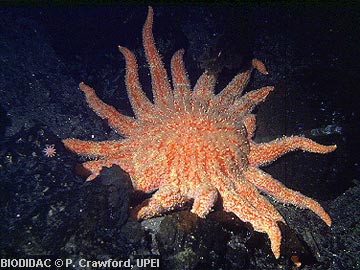
Stelleroidea: seastars and brittle stars.
The most familiar echinoderms are the sea stars, also called starfish or asteroids. Most sea stars have 5 arms with the tube feet projecting from ventral grooves. However, some sea star species have 6, 7 or 10 arms, and the sunflower star may have as many as 25. Some species of cushion stars have very short arms or none at all. The spines of most sea stars are short, but the Crown-of-Thorns, has long, sharp spines that can deliver a venomous sting. Many sea stars live along rocky shores, clinging to the rocks with their tube feet. Others live on muddy or sandy surfaces and use pointed tube feet to walk across or sink beneath the surface.

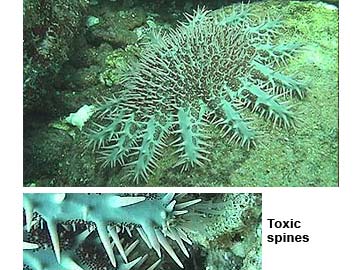
Sea stars are carnivores, feeding mainly on molluscs, crustaceans and polychaete worms. Molluscs are the favorite food of most sea stars. Small gastropods may be eaten whole and the empty shell ejected from the mouth. More commonly, sea stars feed on bivalves which they pull apart by grasping the shells with their tube feet and applying a constant pressure. The sea star inserts its stomach into the gap of an opened shell to digest the mollusc body. Molluscs are not entirely defenseless; they can sense a nearby sea star and will try to escape. Sea stars feed by forcing their stomachs out of their bodies (eversion) onto, or into, the prey. Then they secrete powerful digestive enzymes to break down the prey in it’s own body.
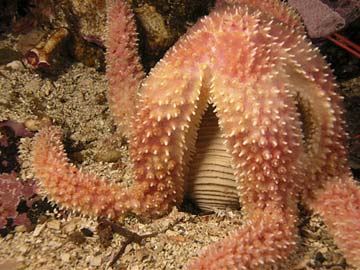
Partially-digested nutrients are sucked back into the stomach region or they are brought in to the body through active transport. Once inside, nutrients are transported by ciliary action into digestive glands in each ray. The food molecules pass into the body fluid for distribution to the skin and other parts of the sea star’s body. In most sea stars, undigested material is pushed out the oral opening, while some material is eliminated through a small anus located on the top (aboral) surface.
Sea stars have considerable powers of regeneration. It is common to find a sea star with small, regenerating arms, and a few species can regenerate their entire body from a single arm.
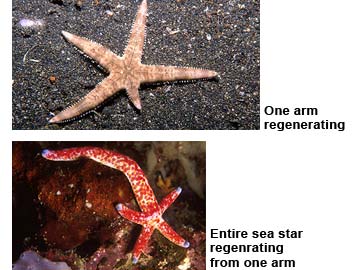
·
The brittle stars resemble sea stars, but have longer, highly flexible arms which enable the animals to make snake-like movements (which is the source of the clade or subclass name Ophiuroidea: Greek. ophis = serpent). Brittle stars can move rapidly over the sand and even swim by flexing their arms. Some brittle stars have very long, thin arms giving rise to the name "serpent stars". The basket star is a type of brittle star with highly branched arms.
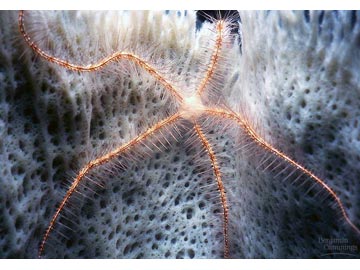
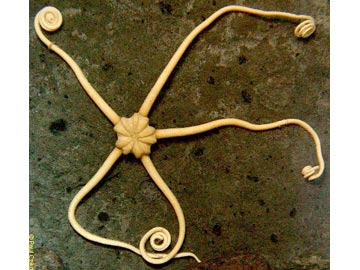
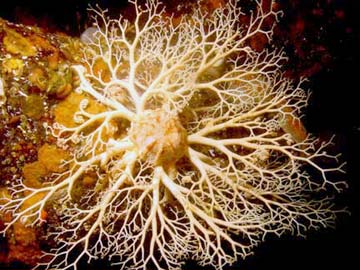
Ophiuroids are carnivores, filter feeders, and scavengers; those of some species use more then one method to obtain food. Mucus on the tube feet can trap phytoplankton, bacteria, and even medusae from the water or particles from sediment that are moved by the tube feet to the mouth; some ophiuroids capture small crustaceans or worms by looping the organisms with their rays. The stomach fills much of the disc, but does not extend into the arms, and ends blindly (that is, it has no anus). Digestion occurs within 10 pouches or infolds of the stomach.
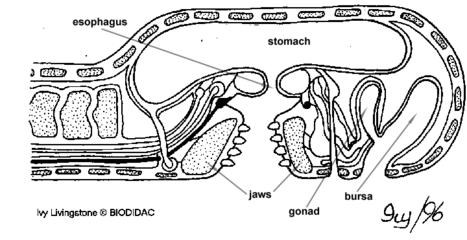
Interestingly many ophiuroids brood their young, commonly in the bursae.
Many species spend most of their life hiding among rocks. Appear to have develop an "eye."
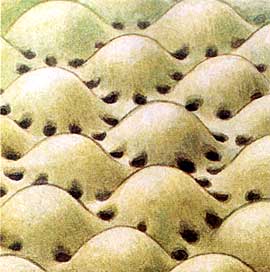
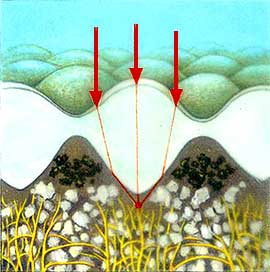
The entire dorsal side of the brittle star is covered with a matrix of calcite crystals shaped into bumps (above left). These bumps act as lenses (see schematic cross section, above right), focusing incoming light (red arrows) on a network of nerves (yellow). Together, the lenses and nerves turn the animal’s back side into a body-size compound eye. The lenses are supported by a layer of irregular calcite, shown in light gray. Special pigment-bearing cells (dark gray) migrate above the lens layer by day, emerging through holes that surround the bumps. In effect they act as echinoderm sunglasses.
Echinoidea
Sea urchins are familiar because their endoskeletons, inappropriately called shells, are found on beaches.
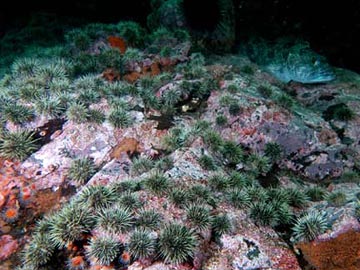
The sea urchins have a rounded, hemispherical body, supported by a more rigid endoskeleton than that of sea stars. Tube feet occur in rows along the dorsal surface as well as beneath the animal, and long spines give sea urchins the appearance of a burr or porcupine. The shell-like endoskeleton is composed of large, interlocking plates that form a solid structure around the internal organs.
The spines of all sea urchins assist in locomotion, but vary in size and shape. Species that burrow in the sand have short spines, whereas those that live in the open have long, sharp spines to deter predators. The pencil urchins have heavy, broad spines that are used to wedge the animal into rocky crevices. One species of tropical urchin, Toxopneusta, has only a few spines but its surface is covered with another defensive structure -- highly poisonous pedicellariae. Poisoning from these pedicellariae has resulted in death for a few people who have handled or encountered these tropical urchins.
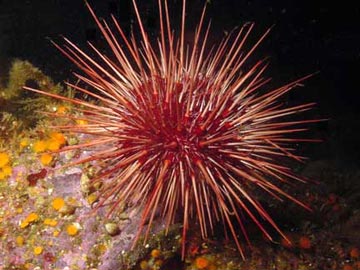

Sea urchins are grazers, feeding on algae and small animals that encrust rocks. They cling to rocks or wander the seabed scraping up food with a unique feeding structure called Aristotle's lantern. Long tube feet on the dorsal side of the body snare stands of algae that float in the water, and the tiny jaw-like structures, pedicellariaes, between spines may also assist in feeding.
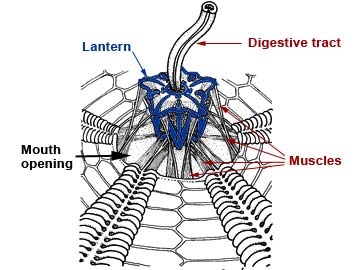

.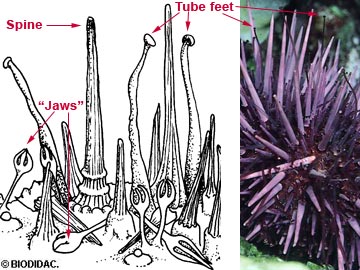
The sand dollars are flattened versions of sea urchins with very short spines.

Sand dollars burrow beneath the sand, feeding on organic matter that is sifted out by the spines and passed to the mouth on cilia. Some species live in areas with gentle ocean currents. They feed by digging their anterior edge into the sediment, with the mouth facing the water current, and capture in-coming microorganisms.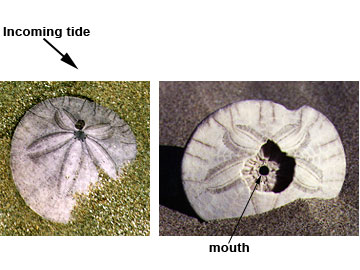
Some sand dollars are asymmetric, revealing a tendency toward bilaterally symmetry and so known as irregular echinoids.
Sea urchins are models for fertilization and developmental studies of deuterostomes.
Sea urchin outbreaks have decimated kelp forests along the western American coast, whereas in other regions, a scarcity of sea urchins has resulted in algal overgrowth that is equally destructive.
Sea urchin gonads are prized as a food delicacy in Japan and parts of Europe. Fishing for green sea urchins has become a major industry in Maine. The sea cucumber is dried and used in soup throughout the orient.
Readily available, they serve as models for deuterostomes in general.